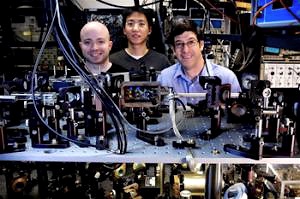Physicists Capture Atoms In Laser Traps
Like bakers measuring the exact same amount of
flour every time they made bread, physicists at The University of Texas at
Austin have used a laser trap to consistently capture and measure the same small
number of atoms.

Like bakers measuring the exact same amount of flour every time they made bread, physicists at The University of Texas at Austin have used a laser trap to consistently capture and measure the same small number of atoms.
Dr. Mark Raizen and his colleagues created what’s called a squeezed number state, where the number of atoms captured in a laser trap was held nearly constant. To reach the atomic number squeezing, the physicists made a box out of sheets of laser light. The laser box had no top–just four sides and a bottom–and held a fixed number of atoms like a cup holding ping-pong balls.
“Suppose we have a trap that works like a cup,” explains Raizen, “and I start putting ping-pong balls in the cup. I reach a point where I can’t put any more balls in without them spilling over. So there’s a hard cut-off on the number that can fit in the cup. That’s the mechanism we use, only our cup is made out of light.”
The other difference, of course, is that Raizen and his colleagues used atoms instead of balls.
Of course, some other folks at the school beat USC.
Posted: Sat - January 7, 2006 at 12:20 PM